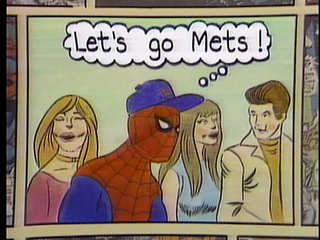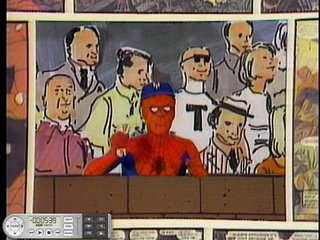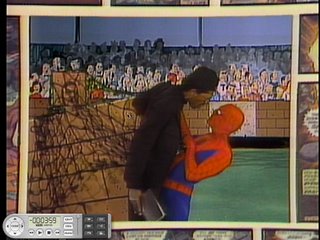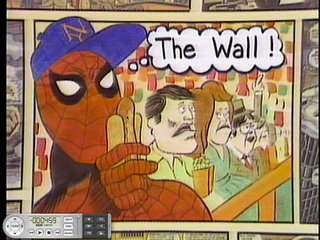Termite (Sequential) Art: Spider-Man: One More Day
 Yeah, it's a film blog. Guess what: I like comics too.
Yeah, it's a film blog. Guess what: I like comics too.Written by J. Michael Straczynski and Joe Quesada
Illustrated by Joe Quesada with Danny Miki
The greatest villainy in all of comics, the fiendish "illusion of change" strikes again, and this time it's erasing some twenty-odd years of continuity. In one misguided, poorly written, and downright upsetting storyline, all those decades of stories, including many of my personal favorites, have vanished as if they never happened in the first place. The reason seems clear, at least to me: in the eyes of some, Spider-Man was getting a bit too manly.
Editor-in-chief of Marvel Comics, Joe Quesada has, for years, argued that a married Spider-Man/Peter Parker (as the character has been since the late 1980s, when he wedded longtime girlfriend Mary Jane Watson) is less viable than a single Spider-Man/Peter Parker. A while back, Quesada helped launch the "Ultimate" line of comics, stripped-down versions of popular Marvel properties with streamlined continuity with no ties to the regular Marvel Universe. In other words, while the Amazing Spider-Man could remain married to Mary Jane the Ultimate Spider-Man was a high school teen dating Mary Jane (and other girls) for the first time. For readers like myself, it was a superb arrangement. The books were different but both, thanks to writers J. Michael Straczynski and Brian Michael Bendis, respectively, were good reads. One would have thought this an ideal compromise, particularly because it doubles the amount of money the company can get out of a rube like me.
The situation probably could have gone on forever were it not for one Sam Raimi and his remarkably successful and popular films about your friendly neighborhood wallcrawler. Suddenly the Spider-Man most familiar to people isn't the one gracing the monthly pages of Marvel Comics; it's the one gracing the biannual silver screens of multiplexes around the world. And that Spider-Man isn't married, has never been married. Now, in addition to whatever personal preference Quesada might have held, there was a clear commercial imperative for a breakup: the move alligns the world of the comics with the world of the films. At the end of One More Day, the story that tells the end of Peter and Mary Jane's marriage, Spider-Man's world has literally been transformed all around him, into one that looks remarkably like the one Raimi presented onscreen. In the final scene of Part 4, for example, Aunt May's house in Queens looks exactly like the one from the first two films, right down to the stairwell just behind the kitchen table. That sort of synergy has got to be good for business. From that perspective, the move makes a whole lot of sense.
 From a story perspective, not so much. The concept Quesada and Straczynski cooked up to break the two apart is truly a bizarre one. It spins out of Marvel's recent Civil War series, where a new law required all super-heroes to surrender their identity to the federal government. Peter Parker revealed his secret on national television, but later decided to rebel against the so-called Super-Hero Registration Act, turning him and his family into fugitives. While on the run from both friends and enemies, a sniper aiming for Peter accidentally shoots Aunt May instead. In One More Day, Peter learns that Aunt May's injuries are fatal and there is nothing medical science can do for her. Feeling responsible for her impending death (just as he still feels responsible for his Uncle Ben's death years earlier), he seeks supernatural assistance and eventually encounters Mephisto, the Marvel Comics version of Satan. He offers Peter a choice: Aunt May's life for his marriage to Mary Jane. After a couple of pages of half-hearted hand-wringing the deal is done, the history of the world is rewritten and now it is as if Peter and MJ were never hitched at all (and as if Peter had never told Aunt May he was Spider-Man, and so on).
From a story perspective, not so much. The concept Quesada and Straczynski cooked up to break the two apart is truly a bizarre one. It spins out of Marvel's recent Civil War series, where a new law required all super-heroes to surrender their identity to the federal government. Peter Parker revealed his secret on national television, but later decided to rebel against the so-called Super-Hero Registration Act, turning him and his family into fugitives. While on the run from both friends and enemies, a sniper aiming for Peter accidentally shoots Aunt May instead. In One More Day, Peter learns that Aunt May's injuries are fatal and there is nothing medical science can do for her. Feeling responsible for her impending death (just as he still feels responsible for his Uncle Ben's death years earlier), he seeks supernatural assistance and eventually encounters Mephisto, the Marvel Comics version of Satan. He offers Peter a choice: Aunt May's life for his marriage to Mary Jane. After a couple of pages of half-hearted hand-wringing the deal is done, the history of the world is rewritten and now it is as if Peter and MJ were never hitched at all (and as if Peter had never told Aunt May he was Spider-Man, and so on).What might be most galling in this entire sordid affair is the fact that this storyline was pitched to readers as a grand send-off to Straczynski, the creator of Babylon 5 and the regular monthly writer of Amazing Spider-Man since 2000. After years of stories so dreadful even I, hardcore Spidey fan that I am, stopped reading the series, Straczynski gave the book a renewed sense of purpose and its central character a clear, expressive voice. Most importantly, he was willing (some might say too willing) to push Peter Parker in new directions. He eliminated most of Peter's time at the Daily Bugle, where he'd spent decades as a freelance photographer and set him up as a science teacher at his alma mater, Midtown High School. He pushed the character through an otherworldly metamorphosis (in a storyline called "The Other") giving him enhanced powers. Most significantly, he finally revealed Peter's secret identity to his Aunt May (this was prior to the series of events where he ripped off his mask in front of the entire world). As part of the bargain with Mephisto, all of these changes were wiped away, as if they'd never happened in the first place.
 For better or worse — and, without question, Straczynski's run, particularly in the last couple years, had some lackluster moments — Straczynski's Spider-Man was one that ventured into new territory and explored new avenues. The status quo established at the end of One More Day by Quesada and his new writers is a deliberate return to the past. Even ignoring the troubling moral implications of having your company's most popular super-hero make a literal deal with the devil, the story establishes a new continuity that is not only old-fashioned, it completely erases the accomplishments of a particularly progressive writer. What kind of happy send off is that? The final page of Amazing Spider-Man #545 is stacked with quotes from J.M.S.' peers, celebrating his achievements on the book. This is the proverbial gold watch; he's barely out the door and they've already made it so he never even existed.
For better or worse — and, without question, Straczynski's run, particularly in the last couple years, had some lackluster moments — Straczynski's Spider-Man was one that ventured into new territory and explored new avenues. The status quo established at the end of One More Day by Quesada and his new writers is a deliberate return to the past. Even ignoring the troubling moral implications of having your company's most popular super-hero make a literal deal with the devil, the story establishes a new continuity that is not only old-fashioned, it completely erases the accomplishments of a particularly progressive writer. What kind of happy send off is that? The final page of Amazing Spider-Man #545 is stacked with quotes from J.M.S.' peers, celebrating his achievements on the book. This is the proverbial gold watch; he's barely out the door and they've already made it so he never even existed.The obvious disconnect between the editorial intent and the writer's was made unusually clear during a rather candid message board post written recently by Straczynski in response to widespread displeasure with One More Day. He'd actually asked to have his name removed from this so-called "tribute":
"...there's a lot that I don't agree with, and I made this very clear to everybody within shouting distance at Marvel, especially [Quesada]. I'll be honest: there was a point where I made the decision, and told [Quesada], that I was going to take my name off the last two issues of the One Mre Day arc. Eventually [Quesada] talked me out of that decision because at the end of the day, I don't want to sabotage [Quesada] or Marvel, and I have a lot of respect for both of those."
Quesada responded by insisting that Straczynski knew full well what sort of story he was getting hired to write, and that they disagreed only in the particulars and not in the execution. He also explains that a lot of their differences grew out of the fact that much of One More Day's ending had to be rewritten to reflect the new Spider-Man books that were already being produced months before the series actually finished; to change the conclusion now would mean to scrap months of already completed work. Once again, it's a decision that makes perfect business sense and terrible story sense.
 But then narrative corners were cut anywhere Quesada (and, yes, Straczynski) could. One More Day is a four issue story in which the first full issue (cover price $3.99) is little more than a well-illustrated prologue. According to the title ("One More Day"), this is a story about what someone does with the love of their life when they have only one more day to spend with each other. Straczynski and Quesada's space management is so bad, and the execution so poorly botched, that we don't actually get to see what Peter and Mary Jane would do with the day. Even if you resigned yourself to the story's outcome; heck, even if you wanted to see it because you agreed with Quesada's rationale, you couldn't even savor that last day the title promised because it wasn't in the book.
But then narrative corners were cut anywhere Quesada (and, yes, Straczynski) could. One More Day is a four issue story in which the first full issue (cover price $3.99) is little more than a well-illustrated prologue. According to the title ("One More Day"), this is a story about what someone does with the love of their life when they have only one more day to spend with each other. Straczynski and Quesada's space management is so bad, and the execution so poorly botched, that we don't actually get to see what Peter and Mary Jane would do with the day. Even if you resigned yourself to the story's outcome; heck, even if you wanted to see it because you agreed with Quesada's rationale, you couldn't even savor that last day the title promised because it wasn't in the book.Now Amazing Spider-Man takes off in a new — or rather old, but made to look contemporary — direction with a host of new writers (the series will now appear three times a month, replacing the prior format where Amazing was joined by sister series Sensational and Friendly Neighborhood Spider-Man). They will attempt to pick up the pieces and move on. These stories may be good. But if fan reaction remains as negative as mine (and if you do a Google search for "Spider-Man" "One More Day" and "sucks" you'll see what I mean) the comics franchise could be in long-term trouble. This shameless deus ex machina wiped away decades of stories in a single stroke, but the creators following it may find the damage caused in its wake a bit harder to erase.
Labels: Comic Books, Spider-Man














